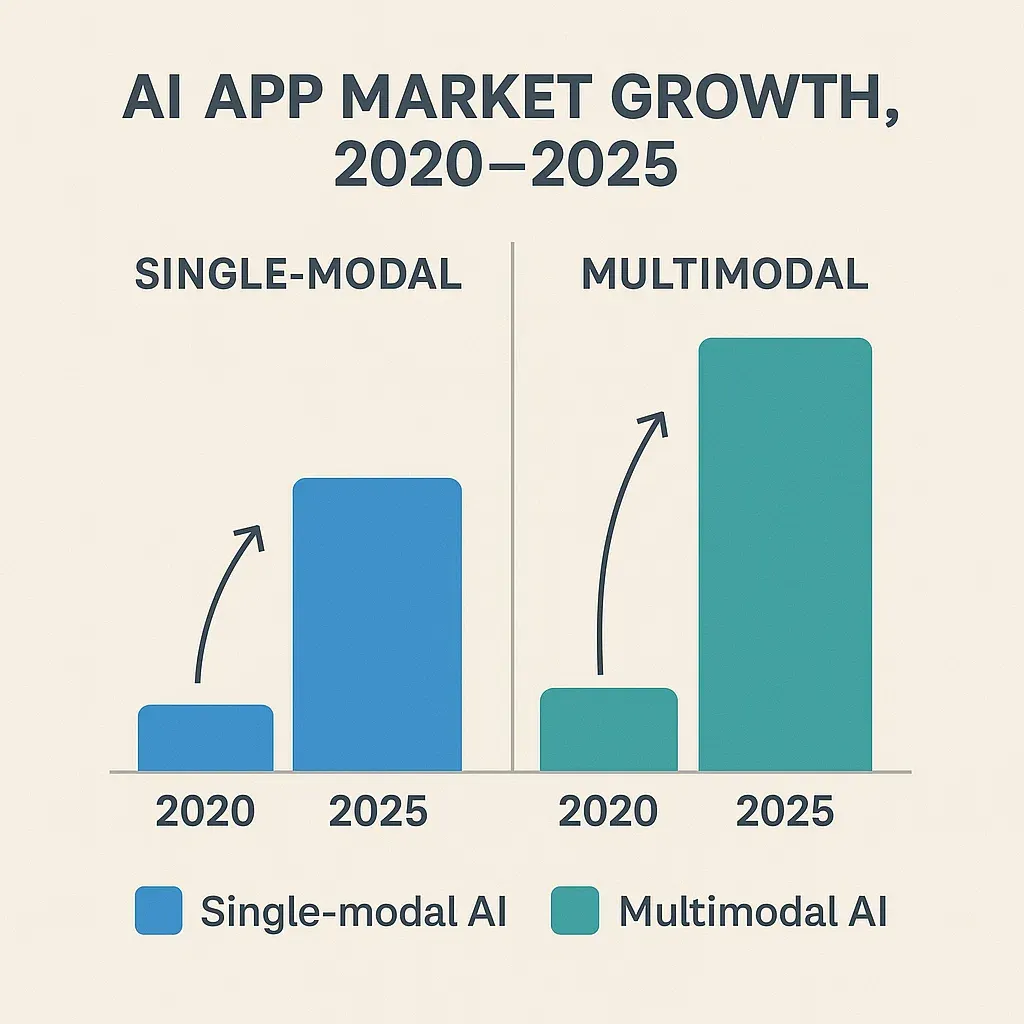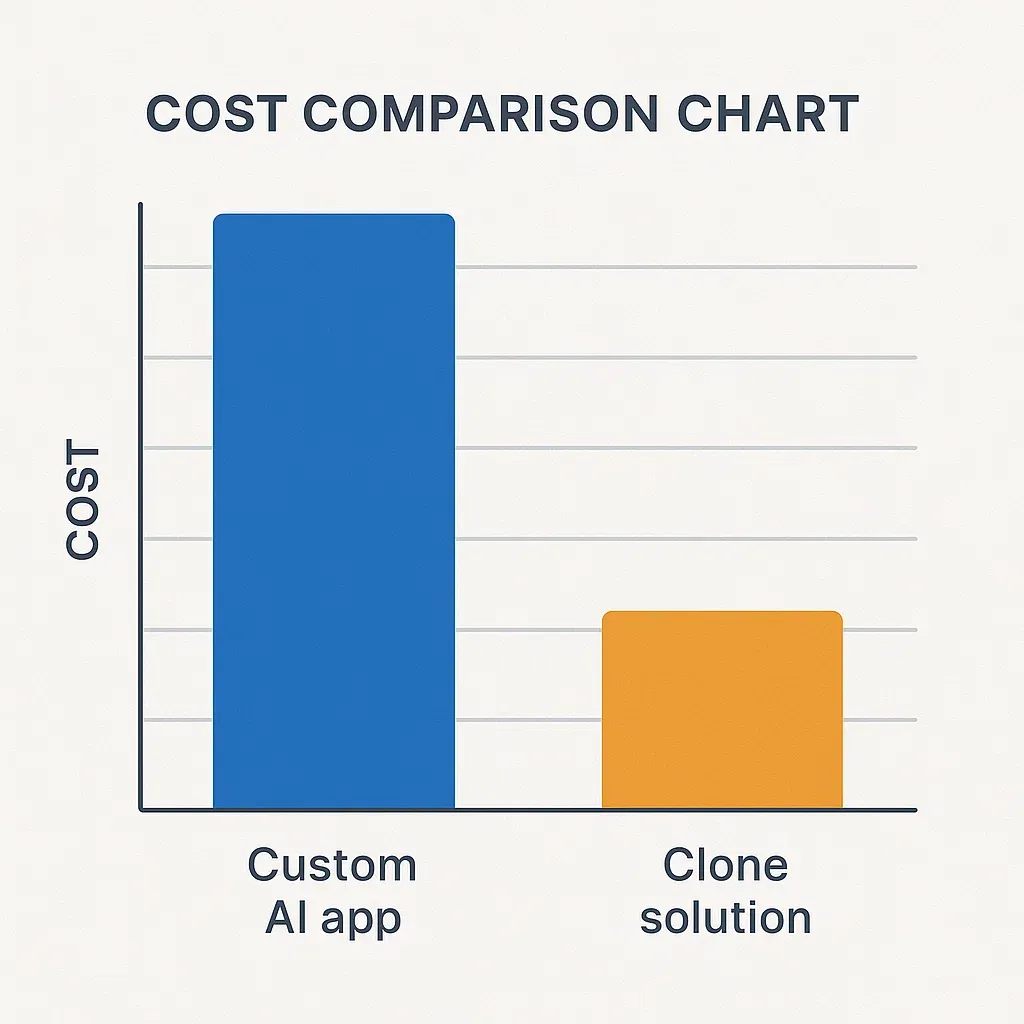2025 is shaping up to be a groundbreaking year for multimodal AI platform apps—solutions that combine various data types like text, images, audio, video, and sensor input into a single, intelligent ecosystem. From personalized learning to AI-enhanced productivity tools, these apps are revolutionizing how people interact with digital experiences.
For startup founders, entrepreneurs, and digital agencies, this isn’t just an emerging tech trend—it’s a goldmine. The rapid acceleration of generative AI, increasing consumer comfort with intelligent apps, and the wide availability of API-based tools (from OpenAI, Meta, and others) are fueling a massive wave of innovation and investment.

Read more: How to Build a Profitable Multimodal AI Platform: Turning Intelligence into Income
Why Multimodal AI Apps Are a Hot Opportunity in 2025
According to Statista, the global AI software market is projected to surpass $300 billion by 2025, with a significant chunk driven by multimodal systems. These apps go beyond traditional text-based or image-based AI by integrating multiple sensory inputs, leading to smarter, more human-like interactions.
CB Insights reports a notable uptick in funding for startups that combine generative AI with natural language processing, computer vision, and audio recognition—hallmarks of multimodal platforms. In Q1 2025 alone, multimodal startups saw a 65% rise in VC funding compared to the previous year.
From a user behavior standpoint, consumers now expect intuitive, conversational interfaces. Apps like ChatGPT (with voice and image support), Google Gemini, and RunwayML are showing that multimodality is not a feature—it’s a standard.
Yet, there are still gaps in niche markets, such as healthcare, education, retail, and productivity, where no clear leaders have emerged. That makes this the perfect time for founders to step in.

Top Profitable Multimodal AI App Ideas to Launch in 2025
1. AI-Powered Personal Learning Companion
A personalized tutor that adapts to a user’s voice, writing, quiz answers, and emotional tone to deliver tailored learning experiences.
- Monetization Strategy: Subscription plans, premium content unlocks, institutional licensing
- Why It Works in 2025: Education tech is booming, and demand for AI tutoring is soaring post-pandemic.
2. Virtual Health Coach App
A voice-and-camera-based app that analyzes facial cues, tone, and responses to offer mental health check-ins and wellness advice.
- Monetization Strategy: Monthly subscriptions, affiliate products (wearables, health kits), B2B wellness packages
- Why It Works in 2025: Health-conscious consumers are seeking non-intrusive yet smart wellness tools.
3. AI Legal Assistant
An AI chatbot that reads documents, listens to dictations, scans IDs, and provides case analysis or legal documentation help.
- Monetization Strategy: Freemium model with paid tiers for document generation, lawyer matching, or consultations
- Why It Works in 2025: Legal tech is underserved, and AI can democratize access to legal advice.
4. Smart Recipe & Grocery Planner
Users upload fridge images, speak preferences, and get recipes plus auto-generated grocery lists with links to delivery platforms.
- Monetization Strategy: Affiliate commissions, premium recipe packs, ad-free version
- Why It Works in 2025: Combines convenience, health, and AI efficiency—all high-demand verticals.
5. AI Sales Meeting Companion
An AI assistant that joins meetings (Zoom, Google Meet), analyzes video cues, summarizes discussions, and recommends follow-ups.
- Monetization Strategy: SaaS model for sales teams, integrations with CRM systems
- Why It Works in 2025: Remote work continues, and sales productivity is mission-critical for many firms.
6. Multimodal Travel Planner
Speak your destination, show your passport, upload your past trip photos—and the AI creates a full itinerary with booking options.
- Monetization Strategy: Commission on bookings, premium itineraries, travel insurance upsells
- Why It Works in 2025: Post-pandemic revenge travel has evolved into experience-first travel, driven by personalization.
What Makes an App Profitable in the Multimodal AI Niche?
To become one of the most profitable multimodal AI apps to launch in 2025, your app needs to:
- Generate recurring revenue (subscriptions, SaaS, tiered access)
- Retain users with smart, adaptive personalization
- Operate lean through automation and cloud-native scalability
- Acquire users efficiently using content, community, or niche targeting
Building such apps from scratch is costly and slow. That’s why many smart founders turn to clone app development. Platforms like Miracuves offer white-label, fully customizable multimodal AI clones—cutting your time-to-market by months and costs by 40–60%.
Read more: Building a Next-Gen Multimodal AI Platform from Scratch: A Complete Guide
Cost to Build a Multimodal AI App in 2025
Here’s a realistic breakdown:
- Basic Version: $20,000 – $50,000
- Advanced Features (multilingual, AR/VR, real-time processing): $60,000 – $150,000+
- Enterprise-Grade (HIPAA compliance, ML training modules, etc.): $200,000+
Launch Your Multimodal AI Platform in Just 3–6 Days — Go Live with Miracuves from $3,000 to $3,500!
Key cost drivers:
- Platform choice (web, mobile, or cross-platform)
- Tech stack (OpenAI APIs, Google Vision, custom ML models)
- Backend logic (data sync, storage, multi-tenant architecture)
- UI/UX complexity (multimodal interaction design)
Clone solutions from Miracuves can bring the cost down to as low as $10,000 for a launch-ready MVP—with room to scale.

Tips for Founders to Launch a Successful Multimodal AI App
- Start with an MVP: Don’t overload features—focus on a core value that uses 2–3 data modalities effectively.
- Prioritize UI/UX: Multimodal apps require seamless transitions between voice, image, and text. User friction kills retention.
- Validate Early: Use no-code mockups and waitlists to test demand before full development.
- Build on Scalable Tech: Cloud infrastructure, modular APIs, and data compliance should be baked in from the start.
- Market Creatively: Highlight real-life use cases in short-form videos or micro-content to spark virality.
Read more: Cracking the Code: How to Market Your Multimodal AI Platform Post-Launch
Conclusion
The most profitable multimodal AI apps to launch in 2025 are those that merge utility with intelligence—using voice, vision, and text to solve everyday problems smarter and faster. From legal bots to learning platforms, the market is ripe with opportunity.With demand skyrocketing and users expecting seamless AI experiences, now is the best time to build your multimodal AI platform. Using a clone app development approach not only saves time and budget, but also sets you up for scale with proven architectures.
At Miracuves, we help innovators launch high-performance app clones that are fast, scalable, and monetization-ready. Ready to turn your idea into reality? Let’s build together.
FAQs
Q:1 How much does it cost to build a multimodal AI app?
The cost to build a multimodal AI app with Miracuves ranges from $3,000 to $3,500, with a complete Go-Live setup in just 3–6 days.
Q:2 What features should a successful multimodal AI app include?
Seamless voice/image/text input, real-time processing, cloud storage, user personalization, and secure APIs.
Q:3 Is it better to build from scratch or use a clone solution?
Clone solutions offer faster launches, lower costs, and proven architectures—ideal for most startups.
Q:4 Can clone apps be customized for niche use cases?
Yes, Miracuves clone platforms are modular and easily customizable to fit industry-specific needs.
Q:5 Are multimodal apps scalable for enterprise use?
Absolutely—when built on cloud infrastructure with proper backend logic, these apps scale easily.
Q:6 What are some ideal industries for multimodal AI apps?
Education, healthcare, legal, travel, productivity, and e-commerce are all high-potential sectors.
Related Articles:








